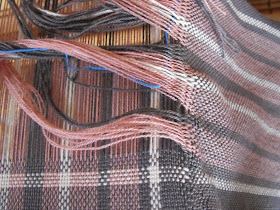We pretty much always share our successful weaving projects, but rarely share our failures ...not so today!
The idea of a V scarf is that part of the scarf is woven and then cut off the loom. The warp is tied back up and the other half of the scarf is woven and at the end of the scarf the two pieces are woven together to make a V shape. But that's not quite what happens here!
The idea of a V scarf is that part of the scarf is woven and then cut off the loom. The warp is tied back up and the other half of the scarf is woven and at the end of the scarf the two pieces are woven together to make a V shape. But that's not quite what happens here!
The first thing to do with this scarf is to pull a
striped warp. I chose to go with bold stripes in pink merino wool with grey and cream in merino/silk blend. Mum went with more and thinner stripes in
brown merino/ silk blend and orange and cream merino wool.
This grey and pink photo shows the first arm of the
scarf woven, you can see the filler to keep the open edge tidy; this is the
side that is going to be woven into the V shape. Venetian blinds were used to count off
the 17 inches needed for the V shaped plaid section to be woven later.
The warp gets tied on again and the second arm of the
scarf is woven. Now is the start of the
interesting part weaving in the first arm.
The extra filler is removed from the open edge and small bundles were
made to keep the threads tidily tucked away and in order.
We both had a difficult time with weaving the V shape
plaid, it started out really well, but soon disaster loomed (pun intended).
It became increasingly difficult to line up the scarf edges so that the butting edges weren't too tight and crammed the join; or too loose and sleazy. The first inch was unwoven so many times that it started to fray the warp threads.
It became increasingly difficult to line up the scarf edges so that the butting edges weren't too tight and crammed the join; or too loose and sleazy. The first inch was unwoven so many times that it started to fray the warp threads.
The beater bar also contributed to the mess; as it was pulled against the fell of the cloth it would crush the web of the already woven arm of the
scarf and that created puckering and ended up pulling and waving the plaid lines. We both also had some problems with the last thread on the already woven section migrating away from the fell of the cloth and so the whole thing got worse and worse!
I even tried to beat with a hair pick, to push the yarn in instead of using the
beater bar. It did make a better
transition and the plaid lines were straighter but it was a different beat and
as you can see in the photo it puckered too!
With hindsight part of the problem was the yarn choices, the merino/silk blend was slightly larger in grist than the plain merino wool and the merino yarn was definitely more springy than the merino/silk blend. I think the sett also contributed to the problem, these scarves were sett at 18 epi and I think a looser sett may have worked better. After many, many, many attempts at managing the beat to account for the grist and sett differences, we decided to bail and to admit defeat and to literally cut our losses!
The closing garden shot was taken last week before the
frost came and killed the lovely pink Chrysanthemum (Sheffield Hillside Pink). In the foreground is a Golden Smoke Tree (Cotinus Coggyria 'Golden Sprite') and Maiden Grass (Miscanthus sinesis' Morning Light')
















